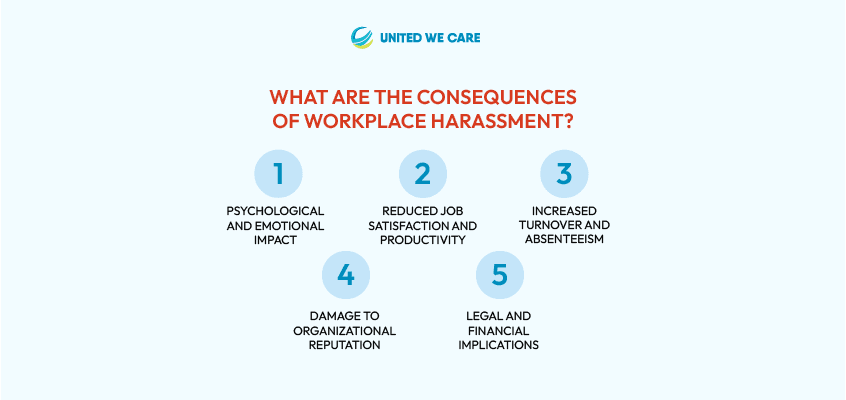Introduction
Workplace harassment is an unwelcome and offensive behavior or actions directed towards an individual or group within a work environment. It involves actions that create a hostile, intimidating, or offensive atmosphere, often based on gender, race, religion, sexual orientation, or disability. Workplace harassment undermines employees’ well-being, productivity, and dignity, and organizations are responsible for preventing and addressing such misconduct.
“People need to feel safe to be who they are—to speak up when they have an idea, or to speak out when they feel something isn’t right.” – Eunice Parisi-Carew [1]
What is Workplace Harassment?
Workplace harassment is a pervasive issue that affects employees and organizations across various industries. Conflicts in the workplace are bound to happen. However, there is a difference between conflict and harassment. Workplace conflict refers to disagreements or disputes between individuals or groups. In contrast, workplace harassment involves any unwelcome behavior, conduct, or action directed at an individual or a group, creating an intimidating, hostile, or offensive work environment. Conflict can be resolved through communication, while harassment requires addressing power imbalances and ensuring a safe workplace. Workplace harassment can have damaging effects on individuals and the overall productivity of organizations [2].
Workplace harassment can take various forms, including verbal abuse, sexual harassment, bullying, discrimination based on gender, race, religion, or disability, and other forms of mistreatment. The consequences of workplace harassment can be severe, leading to increased stress levels, decreased job satisfaction, decreased performance, and a higher likelihood of turnover among victims. Moreover, workplace harassment negatively impacts the work climate, causing reduced employee morale and increased absenteeism [4].
Organizations increasingly recognize the importance of addressing workplace harassment to foster a safe and inclusive work environment. Effective prevention and intervention strategies include clear policies, training programs, confidential reporting mechanisms, and prompt investigation and resolution of complaints. Such measures aim to promote a culture of respect, equality, and professionalism, ensuring the well-being and productivity of employees [3].
Is Workplace Harassment More Common Than You Think?
Workplace harassment is more common than you might think. According to a 2021 Equal Employment Opportunity Commission (EEOC) survey, there were 67,425 workplace harassment cases reported in the United States. This number has steadily increased in recent years, although 75% of these cases go unreported [3].
Workplace harassment can take many forms, including [4]:

- Sexual Harassment: Sexual harassment includes unwelcome sexual advances, requests for sexual favors, and other verbal or physical conduct of a sexual nature.
- Racial Harassment: Unnecessary comments regarding race, color, religion, sex (including pregnancy), national origin, age (40 or older), disability, genetic information, or retaliation can be considered racial harassment. It can include offensive jokes, slurs, or other conduct that creates a hostile work environment.
- Ageist Harassment: Offensive jokes, slurs, or other conduct that makes age-related assumptions about a person’s abilities or worth count as ageism harassment.
- Religious Harassment: Religious harassment can include offensive jokes, slurs, or other conduct that makes religious assumptions about a person’s beliefs or practices.
- Harassing Conduct: Bullying, hazing, or other conduct that makes a person feel uncomfortable or unsafe falls under harassing conduct.
It is essential to raise awareness, promote reporting mechanisms, and implement preventive measures to address this pervasive issue.
What are the Consequences of Workplace Harassment?
Workplace harassment has significant consequences for both individuals and organizations [4]:

- Psychological and Emotional Impact: Victims of workplace harassment often experience increased levels of stress, anxiety, depression, and decreased self-esteem. It can lead to long-lasting psychological effects and have a detrimental impact on the mental well-being of individuals.
- Reduced Job Satisfaction and Productivity: Workplace harassment can decrease job satisfaction, lower organizational commitment, and reduce productivity. Victims may become disengaged from their work and experience a decline in performance.
- Increased Turnover and Absenteeism: Individuals who experience workplace harassment are more likely to contemplate leaving their job or organization. Additionally, victims of workplace harassment report higher absenteeism rates.
- Damage to Organizational Reputation: Incidents of workplace harassment can tarnish an organization’s reputation, leading to negative publicity and loss of public trust, which can have long-term consequences for recruitment efforts and employee morale.
- Legal and Financial Implications: Workplace harassment can result in legal action, leading to costly litigation, settlements, or fines for the organization. Legal consequences can further damage the organization’s financial stability and public image.
How to Protect Yourself from Workplace Harassment?
Protecting oneself from workplace harassment is crucial for maintaining a safe and healthy work environment. There are several strategies individuals can employ to protect themselves [5]:

- Familiarize Yourself with Workplace Policies: Understand your organization’s policies on harassment, including reporting procedures and available resources for support.
- Document Incidents: Keep a record of any incidents of harassment, including dates, times, locations, and descriptions. This documentation can be helpful if you decide to report the harassment.
- Seek Support: Reach out to trusted colleagues, friends, or family members to discuss your experiences and seek emotional support. It can help alleviate the negative impact of harassment.
- Report Incidents: If you experience harassment, report it to the appropriate channels within your organization, such as human resources or a designated authority. Follow the established reporting procedures and provide detailed information about the incidents.
- Utilize Anonymous Reporting Mechanisms: Some organizations offer anonymous reporting systems that allow individuals to report harassment without revealing their identities, providing safety for those who fear retaliation.
- Educate Yourself: Stay informed about your rights, legal protections, and resources available to victims of workplace harassment. Knowledge empowers individuals to take appropriate action and seek assistance when needed.
Conclusion
Workplace harassment poses significant threats to individuals and organizations. It undermines employee well-being, job satisfaction, and productivity while damaging organizational reputation. Addressing workplace harassment requires a multi-faceted approach, including transparent policies, training programs, effective reporting mechanisms, and prompt resolution of complaints. Creating a safe and inclusive work environment is crucial to protect employees, promote dignity, and foster a culture of respect and professionalism in which everyone can thrive.
If you are experiencing workplace harassment as an employee, consider the following options:
- Seek support from expert counselors at United We Care.
- Explore the resources and content available at United We Care for guidance.
- Connect with our team of wellness and mental health experts who can provide personalized assistance and guidance on effective methods for maintaining your well-being in the face of harassment.
References
[1] “A quote from Collaboration Begins with You,” Quote by Eunice Parisi-Carew: “People need to feel safe to be who they are—to …” https://www.goodreads.com/quotes/7297271-people-need-to-feel-safe-to-be-who-they-are-to
[2] “What is Workplace Harassment? It’s Types and Ways to Report,” Nurture an Engaged and Satisfied Workforce | Vantage Circle HR Blog, Nov. 26, 2020. https://blog.vantagecircle.com/workplace-harassment/
[3] M. Schlanger and P. T. Kim, “The Equal Employment Opportunity Commission and Structural Reform of the American Workplace,” SSRN Electronic Journal, 2013, Published, doi: 10.2139/ssrn.2309514.
[4] F. I. Abumere, “Understanding Workplace Harassment -Its Varying Types and Consequences,” International Journal of Research and Innovation in Social Science, vol. 05, no. 09, pp. 805–813, 2021, doi: 10.47772/ijriss.2021.5950.
[5] “The National Institute for Occupational Safety and Health (NIOSH),” Choice Reviews Online, vol. 52, no. 08, pp. 52–3982, Mar. 2015, doi: 10.5860/choice.188912.





